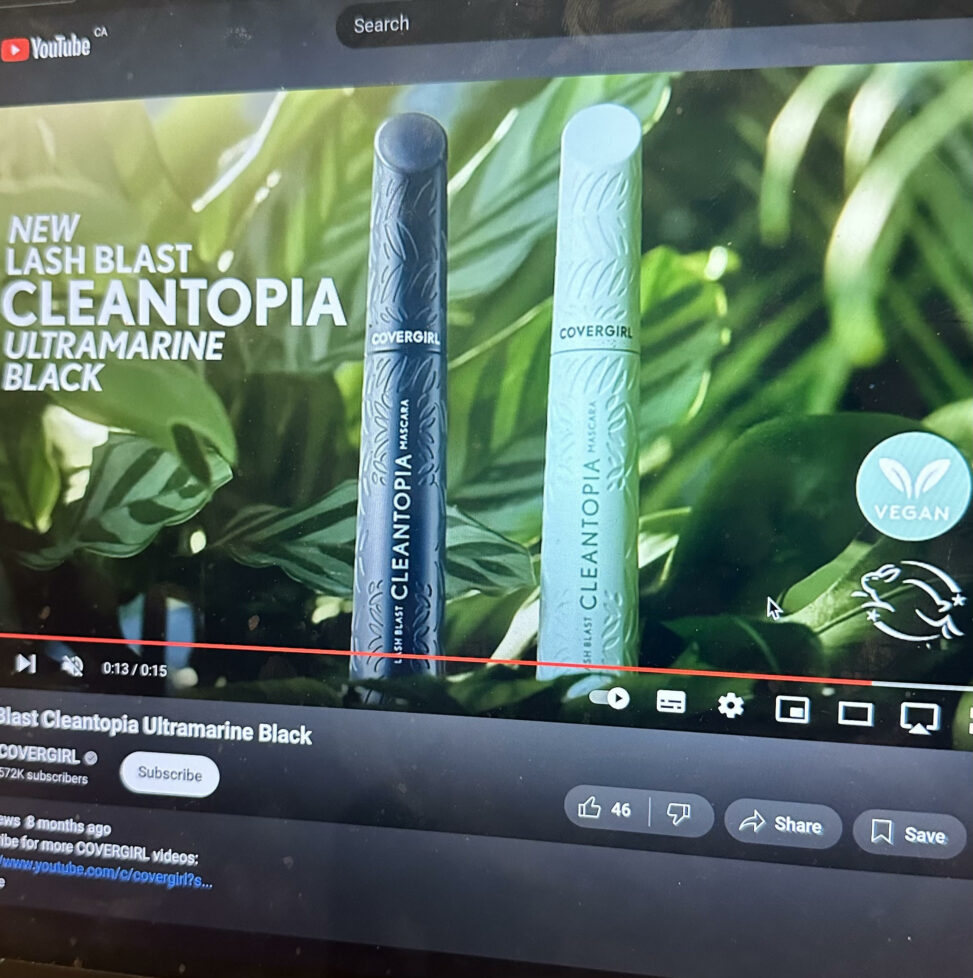Greenwashing Cover girl Cleantopia Mascara
As people become more mindful of their impact of the environment, Brands are changing to adapt to modern sustainability practices. Cover Girl, a well-known name in the Beauty industry since 1961, has gotten involved in this movement by introducing eco-conscious products. Like the Cleantopia Mascara. Cover Girl Markets Cleantopia as a Vegan, Cruelty free, and free from parabens. Cleantopia is one of many products cover girl advertises for their sustainability. This paper with not only discuss the Cleantopia Mascara but also advertising, packaging and potential greenwashing.
Covergirl has a long and impressive history dating back 63 years, making its global debut in 19611. Initially marketing towards younger women and teenage girls, the brand has evolved with the decades. Today, Cover Girl has opened its demographic to include not only young women and teens but also men and non-binary individuals, Positioning itself as an inclusive brand for all. The company has worked closely with the rise of social media. With social media and the internet becoming an intricate part of a consumer’s shopping experience. By working with popular makeup influencers such as James Charels and Tati Westbrook, Cover Girl has enhanced their reach and appeal of their products across platforms such as Facebook, Instagram and YouTube.2
Cover Girl started their promotion of Cleantopia mascara in 2023, marketing it as a plant-based, cruelty-free, vegan, and paraben-free product3. The packaging for this Mascara is designed in shades of green or dark teal, depending on the specific color of the mascara. This visual choice reinforces the vegan association, as many vegan products are often represented with green hues, thereby facilitating immediate recognition of their vegan attributes4. The color wheel works heavily in advertising, making products visually appealing and engaging using green hues subconsciously gives a sense of cleanliness and heath in a product. However, there is no detailed information on whether the packaging is made from recycled materials or if it is recyclable, which is a Crucial aspect of sustainability. The emphasis on natural ingredients and eco-friendly packaging can sometimes overshadow the actual environmental impact. For instance, if the production process or supply chain involved significant carbon emissions or waste, the products green claims might be misleading. Cover Girl is looking to convince consumers to buy Cleantopia mascara, claiming that it offers an eco-friendlier alternative that not only increases lash volume but also incorporates sustainable ingredients and principles. 5
The demograghus of teenagers and adults is increasingly gravitating towards vegan makeup brands. Influenced by contemporary trends and the philosophies promoted by makeup influencers. 6 Additionally, adults are being targeted with marketing that emphasizes a mascara that is not only east to apply and provides a light, clean appearance but is also environmentally friendly and economically viable, with prices ranging from $11 to $13 for a container of Cleantopia mascara.7
The likely hood of success for this advertisement appears to be high, the increasing number of makeup brands, couples with the growing influence of makeup gurus on social media. The demand for sustainable vegan products positions thus advertisement favorable within the current market.8 This brand, with a history spanning 63 years, has demonstrated an ability to evolve in response to consumer preferences while maintaining its established customer base. By aligning with contemporary expectations surrounding vegan makeup and innocative advertising stratagues, the brand effectively addresses the desires of today’s online audience. The promotional material for Cleantopia mascara may be compelling; however, the customer reviews provide a more accurate representation of the products’ performance. Numerous users have reported issues, such as the mascara staining their eyelashes black, which proved difficult to remove after inadvertently sleeping with it on, as well as experiencing allergic reactions to certain ingredients. Although these problems may be from user errors, Cover Girl has acknowledged its responsibility by offering assistance or compensation to affected customers.9
Despite being marketed as vegan, cruelty-free, and clean one must question the veracity of these claims. Since 2015, Cover girl has received certification as cruelty-free from Leaping Bunny, and in 2018, it was recognized by cruelty-free international. Although the parent companies associated with Cover Girl do not fully adhere to cruelty-free standards, they are making efforts to achieve similar certifications. While Cover Girl’s product line is not entirely vegan, the brand does offer a significant number of vegan options. 10
On the surface, Cover Girl appears to be transparent regarding its ethical stance on veganism and cruelty-free practices although no makeup brand is without its shortcoming, Cover Girl seems to be relatively successful in promoting statements that are largely accurate. Cover Girl’s Cleantopia mascara is an example of their commitment to sustainability. Infused with natural ingredients and free from harmful chemicals, it offers a safe, eco-friendly option for all lash types. While cover Girl’s Cleantopia mascara makes several eco-friendly claims, there are areas where more transparency and consistency are needed to fully validate these claims. Consumers should be aware of the potential for greenwashing and seek out comprehensive information about the product’s entire lifecycle, from ingredient sourcing to packaging disposal.
Biblioghraghy
1) “About Us | COVERGIRL®.” n.d. Www.covergirl.ca. https://www.covergirl.ca/about-us.
2) Hassan, Siti Hasnah, Shao Zhen Teo, T. Ramayah, and Nabil Hasan Al-Kumaim. 2021. “The Credibility of Social Media Beauty Gurus in Young Millennials’ Cosmetic Product Choice.” PLOS ONE16 (3). https://doi.org/10.1371/journal.pone.0249286.
3)“Lash Blast Cleantopia Mascara, Volumizing Mascara | COVERGIRL®.” n.d. Www.covergirl.ca. https://www.covergirl.ca/eye-makeup/mascara/lash-blast-cleantopia-mascara.
4) Daggar, Jay. 2022. “Packaging Colour Psychology – How It Affects Your Success.” GWP Group. April 10, 2022. https://www.gwp.co.uk/guides/packaging-colour-psychology/.
5) “CoverGirl Lash Blast Cleantopia Mascara Ingredients (Explained).” 2023. Incidecoder.com. INCIDecoder. December 18, 2023. https://incidecoder.com/products/covergirl-lash-blast-cleantopia-mascara.
6) Santos, Rennan Carvalho dos, Marianny Jessica de Brito Silva, Marconi Freitas da Costa, and Karen Batista. 2023. “Go Vegan! Digital Influence and Social Media Use in the Purchase Intention of Vegan Products in the Cosmetics Industry.” Social Network Analysis and Mining 13 (1). https://doi.org/10.1007/s13278-023-01034-7.
7) https://www.facebook.com/Treehugger. n.d. “Is CoverGirl Cruelty Free, Vegan, and Sustainable?” Treehugger. https://www.treehugger.com/is-covergirl-cruelty-free-vegan-5218143.
AI: Chicago style Citations
MyBib Contributors. 2020. “FREE Chicago Citation Generator [Updated for 2020].” MyBib. January 4, 2020. https://www.mybib.com/tools/chicago-citation-generator.


Sara Westerholm
Emily’s analysis on Covergirl’s wishy-washy greenwashing practices is well-developed, well-supported, and an interesting read.
The history of Covergirl’s inclusivity and efforts with diversity is a great addition to the analysis that gives us context on the branding and image that Covergirl wishes to display to the public eye.
Emily speaks on how while the mascara itself includes clean ingredients, the use of the colour green as a subliminal message of sustainability in Covergirl’s packaging is misleading and dishonest, as there are no actual sustainable aspects to the packaging itself. This is a crucial distinction to make when analysing the claimed eco-friendliness of a product – just because one aspect of the product might be “clean”, does not mean all of it is. I would have been interested to see a breakdown of just how much of a positive environmental impact an eco-conscious mascara makes, if the packaging itself is not remotely good for the planet.
I really enjoyed reading about how Covergirl’s parent companies are not vegan themselves – this is an important critique to make as it gives us the context that their sustainability claims might not be entirely truthful, and that Covergirl as a brand might not be as transparent as we wish to think.
Emily’s sources were plentiful and diverse. It is evident through her analysis that she understands marketing and how it can influence an audience.